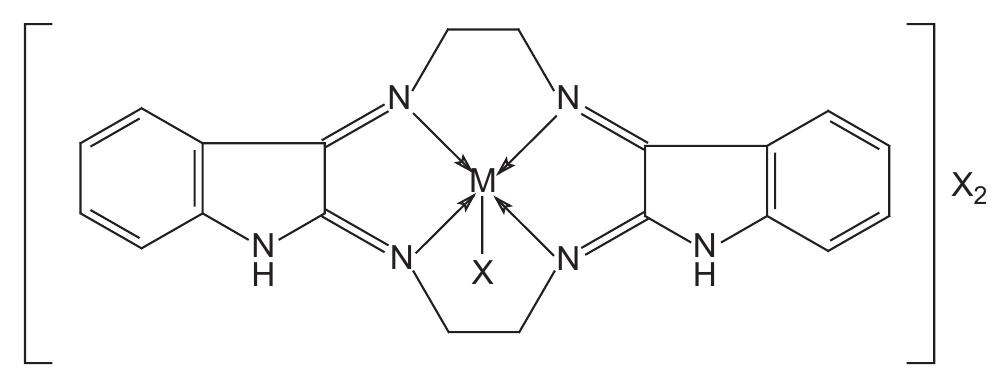Complexos de cobre(II) (3d 9 , S = 1/2) são estáveis e amplamente investigados por espectroscopia de ressonância paramagnética eletrônica (EPR). Já o isoeletrônico níquel(I) é muito menos comum e muito menos estudado. No entanto,...
moreComplexos de cobre(II) (3d 9 , S = 1/2) são estáveis e amplamente investigados por espectroscopia de ressonância paramagnética eletrônica (EPR). Já o isoeletrônico níquel(I) é muito menos comum e muito menos estudado. No entanto, níquel(I) tem interesse biológico, uma vez que o sítio ativo da metil coenzima M redutase (MCR) contém um ligante macrocíclico, F 430 , que coordena o Ni I na sua forma ativa, MCR red1. Assim, o comportamento redox e espectroscópico de complexos tetraazamacrocíclicos de níquel tem importância na química biomimética. O estudo desses complexos é complicado pela dificuldade na obtenção de Ni I a partir dos precursores estáveis de Ni II. A redução de complexos macrocíclicos de Ni II pode gerar Ni I em certos casos, mas em muitos outros leva à redução do macrociclo, gerando um ânion radical orgânico. Estudos anteriores da formação de complexos tetraazamacrocíclicos de Ni I são aqui discutidos em termos da competição entre a redução centrada no metal e a centrada no ligante. Resultados de EPR são particularmente importantes para distinguir esses dois processos de redução, já que a formação de Ni I produz espectros de EPR característicos, similares aos de Cu II , enquanto a redução centrada no ligante gera espectros de EPR agudos, centrados em g = 2,00 e típicos de radicais orgânicos. Mesmo que uma redução centrada no metal ocorra, a geometria do complexo macrocíclico de Ni I resultante é amplanente variável e, consequentemente, o espectro de EPR também será. Nesse caso, a comparação é entre os extremos dos espectros típicos de complexos tetragonais distorcidos (estado fundamental dx2-y2 1 , que inclui as geometrias octaédrica tetragonalmente distorcida, piramidal de base quadrada e quadrado-planar) e dos complexos bipiramidais de base trigonal (estado fundamental dz2 1). Trabalhos anteriores realizados com Cu II foram relacionados com a situação para Ni I. Os diferentes tipos de espectros de EPR desses sistemas são discutidos especificamente usando exemplos inéditos de vários complexos tatraazamacrocíclicos de níquel, incluindo F 430 e a própria MCR. Copper(II) (3d 9 , S = 1/2) complexes are stable and widely investigated by electron paramagnetic resonance (EPR) spectroscopy. In contrast, isoelectronic nickel(I) is much less common and much less investigated. Nickel(I), however, is of biological interest as the active site of methyl coenzyme M reductase (MCR) contains a tetraaza macrocyclic ligand, F 430 , which coordinates Ni I in its active form, MCR red1. As result, the redox behavior and spectroscopy of tetraaza macrocyclic complexes of nickel is of importance in biomimetic chemistry. Such efforts are complicated by the difficulty in generating Ni I from their stable, Ni II , precursors. Reduction of Ni II macrocyclic complexes can afford Ni I in certain cases, but in many other cases can lead instead to reduction of the macrocycle to generate an organic radical anion. Previous studies on the formation of tetraaza macrocyclic complexes of Ni I are discussed in terms of the competition between metal-centered and ligandcentered reduction. EPR results are particularly important in making the distinction between these two reduction processes, as formation of Ni I gives characteristic EPR spectra similar to those for Cu II , while ligand-centered reduction gives narrow EPR spectra at g = 2.00, typical of organic radicals. Even if metal-centered reduction occurs, the geometry of the resulting Ni I macrocyclic complex is highly variable and, as a result, the EPR spectral appearance is highly variable. In this case, the comparison is between the extremes of spectra typical for tetragonally distorted complexes (dx2-y2 1 ground state, which includes tetragonally distorted octahedral, square pyramidal and square planar geometries) and those for trigonal bipyramidal complexes (dz2 1 ground state). Previous work on Cu II was related to the situation for Ni I. The different types of EPR spectra for such systems are specifically discussed using previously unpublished examples of several tetraaza macrocyclic complexes of nickel, including F 430 and MCR itself.



